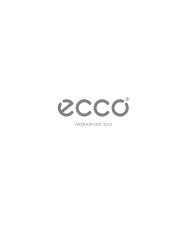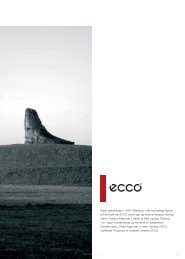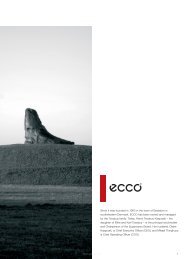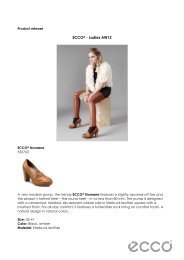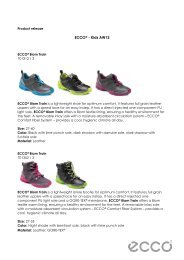Annual Report 2009 - Ecco
Annual Report 2009 - Ecco
Annual Report 2009 - Ecco
You also want an ePaper? Increase the reach of your titles
YUMPU automatically turns print PDFs into web optimized ePapers that Google loves.
eceive a joint taxation contribution from<br />
companies which have been able to use this<br />
deficit to reduce their taxable income.<br />
The tax of this year, which consists of the<br />
current corporate tax, the joint taxation contribution<br />
and the change in deferred tax – also<br />
changes which are caused by reduction of<br />
the corporate tax rate – is part of the income<br />
statement with the share which can be allocated<br />
to profit of the year, and is part of the<br />
equity with the share which can be allocated<br />
to entries in equity.<br />
According to the Danish regulations regarding<br />
mandatory joint taxation, the debt of ECCO Sko<br />
A/S and the Danish subsidiaries towards the<br />
tax authorities is settled when the companies<br />
have paid the joint taxation contribution to the<br />
administrative company.<br />
Deferred tax is calculated as the difference<br />
between the carrying amounts and tax<br />
values of current assets and fixed assets.<br />
Furthermore, the tax value of tax losses<br />
carried forward is recognised in the amount<br />
at which they are expected to be used.<br />
If, on a net basis, there is a tax asset, the<br />
amount of future tax savings is recognised,<br />
provided that it is deemed more likely than not<br />
that the deduction can be offset against future<br />
taxable profits.<br />
Balance sheet<br />
Intangible assets: Intangible assets are recognised<br />
at cost less accumulated amortisation.<br />
Amortisation is charged on a straight-line<br />
basis over 5-10 years.<br />
Development projects: Development projects<br />
which are clearly defined and identifiable and<br />
which are deemed to be marketable in the<br />
form of new products in a future potential<br />
market are recognised as intangible assets.<br />
Development costs are recognised at cost<br />
under intangible assets and are amortised<br />
over the expected useful life of the project,<br />
when the criteria for such treatment are met.<br />
Development costs that do not meet the<br />
criteria for recognition in the balance sheet<br />
are recognised as costs in the income<br />
statement when incurred.<br />
Recognised development costs are measured<br />
at the lower of cost less accumulated amortisation<br />
and writedowns and the recoverable<br />
amount.<br />
Patents and trademarks: The costs of<br />
registering new patents and trademarks<br />
are recognised and amortised over the<br />
term of the patent / trademark or its economic<br />
life (5 years).<br />
Costs of maintaining existing patents /<br />
trademarks are recognised in the income<br />
statement when incurred.<br />
Goodwill on consolidation: Goodwill on<br />
consolidation is determined at the date<br />
of acquisition as the difference between<br />
the cost and the net asset value of the<br />
acquired company applying the Group’s<br />
accounting policies. Consolidated goodwill<br />
acquired from and including 1 January<br />
2002 is capitalised and amortised on a<br />
straight-line basis over the expected useful<br />
economic life, determined on the basis<br />
of earnings projections for the individual<br />
business areas, not to exceed 10 years.<br />
When the Parent Company acquires shares<br />
at a price higher than the value determined<br />
applying the equity method, such excess<br />
value is recognised as an intangible asset<br />
and amortised over the same period as<br />
goodwill on consolidation.<br />
Property, plant, and equipment: Property, plant<br />
and equipment are recognised at cost plus any<br />
revaluation and less accumulated depreciation.<br />
Depreciation is charged on a straight-line<br />
basis over the expected useful lives of the<br />
assets.<br />
The expected useful lives are as follows:<br />
- Buildings 20 years<br />
- Plant and machinery, vehicles,<br />
fixtures and fittings 5 years<br />
- Computer software 3 years<br />
Depreciation is not charged on land and<br />
staff housing. Assets with a cost of less<br />
than DKK 12 thousand per unit are charged<br />
to the income statement in the year of<br />
acquisition. Investment grants are offset<br />
against the assets that form the basis for<br />
the grants.<br />
If an asset type is revalued, this applies to all<br />
assets within that group of assets.<br />
Investments: Investments in subsidiaries are<br />
recognised applying the equity method at<br />
the proportionate share of the equity of the<br />
companies, determined based on the Group’s<br />
accounting policies, less unrealised intercompany<br />
profits.<br />
ECCO’s <strong>Annual</strong> Accounts <strong>2009</strong> / Accounting policies 41



